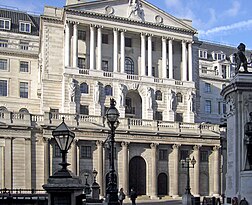Bank of England
The Bank of England is the central bank of the United Kingdom. It is the model on which most modern central banks have been based. It was set up to act as the government's banker, and is still the banker for the British Government. The Bank was privately owned from 1694. The Government took it over in 1946.[3][4]
| Bank of England | |||
| |||
| Headquarters | London, United Kingdom | ||
|---|---|---|---|
| Coordinates | 51°30′51″N 0°05′18″W / 51.51406°N 0.08839°W | ||
| Established | 27 July 1694 | ||
| Governor | Mark Carney | ||
| Central bank of | United Kingdom | ||
| Currency | British sterling | ||
| Reserves | £403,000,000,000[1] | ||
| Base borrowing rate | 0.5%[2] | ||
| Website | www | ||
It is the second oldest central bank in the world (after the Swedish Riksbank), and the world's 8th oldest bank.
In 1998 it became an independent public organisation. Though wholly owned by the government, it has independence in setting monetary policy.[5][6][7][8]
The Bank is one of eight banks authorised to issue banknotes in the United Kingdom. It has a monopoly on the issue of banknotes in England and Wales, and regulates the issue of banknotes by commercial banks in Scotland and Northern Ireland.[9]
The Bank's Monetary Policy Committee manages money supply and interest rates. The Treasury has reserve powers to give orders to the committee "if they are required in the public interest and by extreme economic circumstances" but such orders must be endorsed by Parliament within 28 days.[10]
The Bank's headquarters have been in London's main financial district, the City of London, on Threadneedle Street, since 1734. It is sometimes known as The Old Lady of Threadneedle Street or The Old Lady.[11]
Mark Carney assumed the post of Governor of the Bank of England on 1 July 2013. He succeeded Sir Mervyn King, who took over on 30 June 2003. Carney will serve an initial five-year term, and will seek UK citizenship.[12] He is the first non-Briton to hold the post.
References
change- ↑ Bank of England (6 June 2013). "Bank of England Annual Report 2013" (PDF). Bank of England | Publications. ISSN 1467-016X. Archived from the original (PDF) on 25 March 2014. Retrieved 6 June 2013.
- ↑ "– UK reduces interest rates to 0.5%". BBC News. 5 March 2009. Retrieved 10 May 2010.
- ↑ "House of Commons Debate 29th October 1945, Second Reading of the Bank of England Bill". Hansard.millbanksystems.com. Retrieved 2012-10-12.
- ↑ "Bank of England Act 1946" (PDF). Retrieved 2012-10-12.
- ↑ 1 June 1998, The Bank of England Act 1998 (Commencement) Order 1998 s 2
- ↑ BBC On This Day | 6|1997: Brown sets Bank of England free, Retrieved on 13 September 2009
- ↑ Bank of England | About the Bank, Retrieved on 13 September 2009
- ↑ Bank of England: Relationship with Parliament Archived 2009-07-08 at the Wayback Machine. Bank of England. Retrieved on 21 December 2007
- ↑ "The Bank of England's role in regulating the issue of Scottish and Northern Ireland banknotes". Bank of England website. Archived from the original on 4 February 2012. Retrieved 31 October 2011.
- ↑ "Act of Parliament gives devolved responsibility to the MPC with reserve powers for the Treasury". Opsi.gov.uk. Retrieved 10 May 2010.
- ↑ Historic UK, "The Old Lady of Threadneedle Street". Accessed 18 March 2012.
- ↑ [1]. Accessed 26 November 2012.
